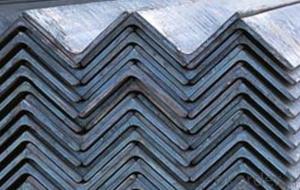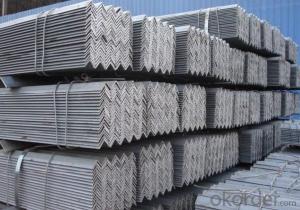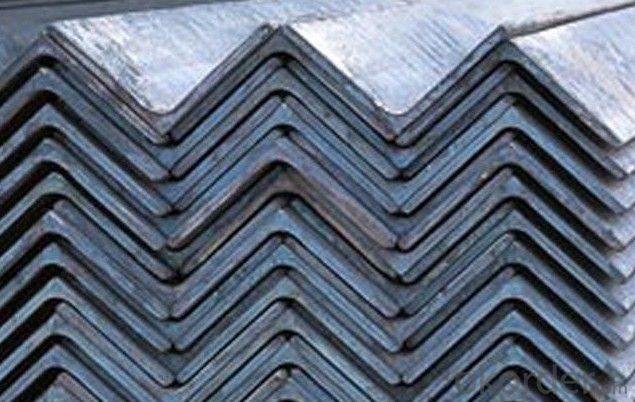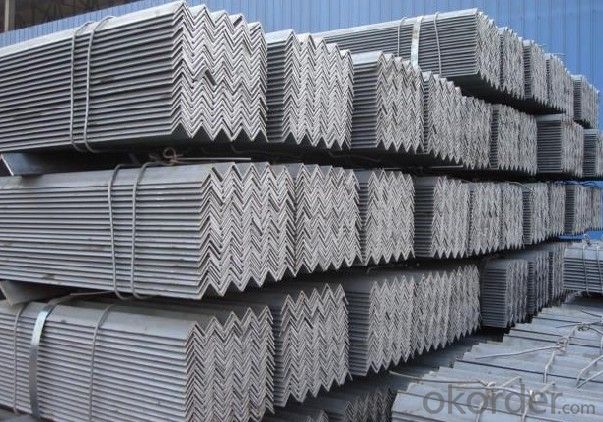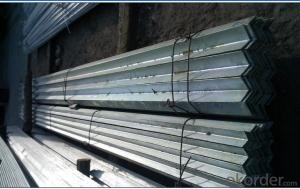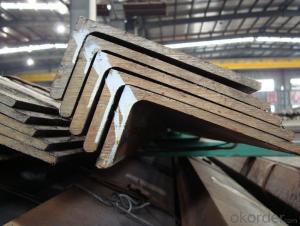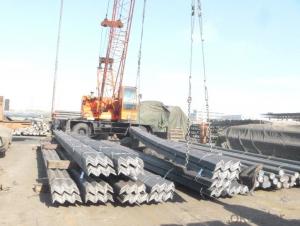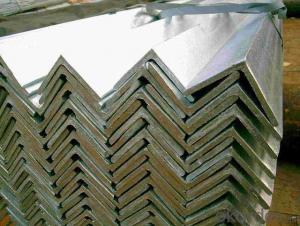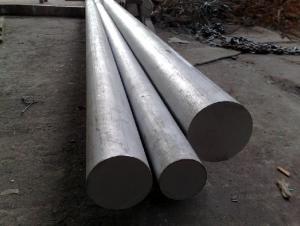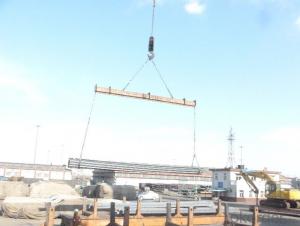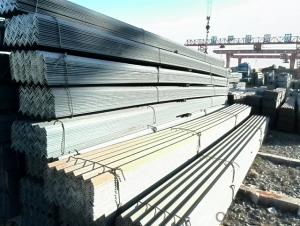High grade hot rolled equilateral angle steel
- Loading Port:
- Tianjin
- Payment Terms:
- TT OR LC
- Min Order Qty:
- 100 m.t.
- Supply Capability:
- 10000 m.t./month
OKorder Service Pledge
OKorder Financial Service
You Might Also Like
Angle called angle, strip steel is perpendicular to each other on both sides into angular.There are equilateral angle steel and unequal angle of. Equilateral angle steel two edge widthequal. The specification is expressed by edge width x edge width * thick edge millimeternumber. Such as "front 30 x 30 x 3", namely said equilateral angle steel edge width of 30 mm,3 mm thick edge. Also available models represent models is the edge width, number of centimeters, such as angle 3#. Models of the same model that in the different edge thickness and size, and thus in the contract documents general boundary angle width, edge thick size fill in complete, avoid use alone model said. Hot rolled equilateral angle steel specifications for 2#-20#. Angle according to the different needs of structure composed of a variety of stress components, but also can be used as a component of the connections between the.Widely used in a variety of architectural and engineering structures, such as beams, bridge,tower, lifting the transport machinery, ships, industrial furnace, reaction tower, container frame and warehouse.
Angle profile
Angle according to the different needs of structure composed of a variety of stress components, but also can be used as a component of the connections between the. Widely used
In a variety of architectural and engineering structures, such as beams, bridge, tower, lifting the transport machinery, ships, industrial furnace, reaction tower, container rack, cable channel support, power piping, bus mounting bracket, and warehouse shelves.
Angle is built with carbon structural steel, is a simple section steel steel, mainly used for metalcomponents and the frame of the plant. In use requires a good weldability, plastic deformation and certain mechanical strength. The production of raw materials for low carbon steel billetsteel billets, finished angle for the hot rolling, normalizing or hot-rolled state of delivery.
Type specification
Mainly divided into equilateral angle steel and equilateral angle steel two categories, includingunequal angle can be divided into equilateral equilateral thick and unequal thickness two.
Angle specifications expressed with side length and edge thickness size. At present domesticsteel specifications for 2 - 20 cm in length, number number, the same horn steel often have 2- 7 different edge thickness. The actual size and edge inlet angle marked on both sides of thethickness and indicate the relevant standards. The general length of more than 312.5px for large angle, 312.5px - 125px for the medium angle, length below 125px for small angle.
Inlet and outlet angle steel orders generally required the use specifications in the main, thesteel is carbon steel grades corresponding. Is the angle in addition to standard number, nospecific composition and performance series. Angle iron delivery length is divided into fixed length, double length two, domestic angle of fixed length of choice scope has 3 9m, 4 12M, 419m, 6 19m four scope according to the specifications of different. Japanese angle length selection range is 6 - 15m.
Section unequal angle height according to the long edge of the width to calculate the scalene angle steel. Refer to section for angular and both sides unequal in length of steel. Is an angleof. Its length from 25mm * 16mm to 200mm * l25mm. From the hot rolling mill and rolling.General specifications for: scalene angle steel angle 50*32-- angle 200*125 thickness of 4-18mm
Unequal angle steel is widely used in all kinds of metal structures, bridges, machinery manufacturing and shipbuilding, building structure and engineering structures, such as beams, bridges, power transmission tower, lifting the transport machinery, ships, industrial furnace, reaction tower, container frame and warehouse etc..
Import and export
China's import and export have a certain angle each batch, mainly imported from Japan andWestern europe. Exports to Hong Kong and Macao, Southeast Asia, the area is mainly on Latin America and Arabia countries etc.. Export production enterprises mainly in Liaoning,Hebei, Beijing, Shanghai, Tianjin and other provinces and cities of iron and steel plant (rolling mill).
Angle for the large variety of imports, small angle and special shape angle, export varieties for the medium angle such as 6, 7, etc..
- Q: Can steel angles be painted or finished for decorative purposes?
- Indeed, steel angles have the potential to be painted or finished in order to achieve decorative purposes. These steel angles, commonly utilized in construction and industrial settings, can undergo painting or finishing procedures to enhance their visual appeal and contribute a decorative element. The act of painting steel angles serves the dual purpose of safeguarding them against corrosion and rust, while also allowing for customization to align with the aesthetic requirements of the particular project. Furthermore, alternative finishes such as powder coating, electroplating, or galvanizing can be employed to augment both the appearance and durability of these steel angles. Through the application of paint or finishing techniques, steel angles can be seamlessly integrated into a variety of architectural and design ventures, thereby serving both functional and visually enticing purposes.
- Q: Can steel angles be bent or formed?
- Yes, steel angles can be bent or formed. Steel angles are commonly used structural elements that are made from steel and have an L-shaped cross-section. They can be bent or formed using various methods such as hot or cold bending, rolling, or press-braking. The specific method used will depend on factors such as the desired angle, radius of bending, and the thickness and type of steel being used. Bending or forming steel angles allows for the creation of different shapes and angles to suit specific structural or design requirements.
- Q: How do you determine the plastic section modulus of a steel angle?
- The plastic section modulus of a steel angle can be determined by calculating the moment of inertia of the angle about its centroid and dividing it by the distance from the centroid to the farthest fiber. This value represents the resistance of the angle to plastic bending and is crucial in analyzing its structural behavior.
- Q: Are steel angles prone to rust or corrosion?
- Yes, steel angles are prone to rust or corrosion. Steel, when exposed to oxygen and moisture, can undergo a chemical reaction called oxidation, resulting in the formation of iron oxide, commonly known as rust. This process can weaken the structural integrity of the steel angles over time. To prevent or minimize rust or corrosion, steel angles are often coated with protective layers, such as paint, galvanization, or other anti-corrosion treatments. Regular maintenance and inspection are also crucial to identify and address any signs of rust or corrosion early on to prolong the longevity and performance of steel angles.
- Q: Are there any specific design considerations when using steel angles?
- Yes, there are several specific design considerations when using steel angles. These include determining the appropriate size and thickness of the angle to ensure structural stability and load-bearing capacity, considering the angle's orientation and connection details for proper installation, and accounting for any potential deflection or buckling issues that may arise due to the long and slender nature of angles. Additionally, it is important to consider the corrosion resistance of steel angles in certain environments and to select the appropriate coatings or treatments to mitigate this potential issue.
- Q: Can steel angles be used as framing members in buildings?
- Framing members in buildings can indeed utilize steel angles. These angles are commonly employed in construction to serve as a structural element for framing, bracing, and supporting various components of a building. With their exceptional strength, durability, and load-bearing capacity, they prove suitable for a wide range of applications in building construction. Steel angles possess the ability to form rigid frames, trusses, and connections, thereby providing stability and support to the structure. Moreover, they can be easily welded, bolted, or connected using other fastening methods, allowing for flexible and efficient construction. In essence, steel angles present themselves as a versatile and dependable choice for framing members in buildings.
- Q: How do you calculate the compression strength of a steel angle?
- To calculate the compression strength of a steel angle, you need to consider the cross-sectional area of the angle and the yield strength of the steel. The compression strength can be calculated by multiplying the cross-sectional area of the angle by the yield strength of the steel.
- Q: Can steel angles be used for shelving units?
- Absolutely! Shelving units can indeed utilize steel angles. These angles are widely employed in construction and industrial settings owing to their impressive robustness and endurance. They offer exceptional structural reinforcement and can effortlessly bear substantial loads, rendering them perfect for shelving units that necessitate the support of considerable weight. Moreover, steel angles are incredibly adaptable and can be effortlessly tailored to suit diverse shelving designs and setups. Whether it be for domestic, corporate, or commercial purposes, steel angles are a dependable option for crafting resilient and enduring shelving units.
- Q: Can steel angles be used in fencing?
- Yes, steel angles can be used in fencing. Steel angles are commonly used in fencing applications to provide structural support and stability. They can be used as posts or crossbars, depending on the specific fencing design. Steel angles are strong and durable, making them suitable for withstanding the elements and providing security. They can be easily welded or bolted together to create a sturdy fencing structure. Additionally, steel angles can be galvanized or coated to enhance their resistance to rust and corrosion, ensuring a long-lasting and low-maintenance fencing solution.
- Q: What are the advantages of using steel angles?
- There are several advantages of using steel angles. Firstly, steel angles provide excellent structural support due to their high strength and durability. They can withstand heavy loads and extreme weather conditions, making them ideal for construction projects. Additionally, steel angles are versatile and can be easily fabricated, cut, and welded to meet specific design requirements. They are also cost-effective, as they have a long lifespan and require minimal maintenance. Lastly, steel angles offer great aesthetic appeal, making them a popular choice for architectural applications.
Send your message to us
High grade hot rolled equilateral angle steel
- Loading Port:
- Tianjin
- Payment Terms:
- TT OR LC
- Min Order Qty:
- 100 m.t.
- Supply Capability:
- 10000 m.t./month
OKorder Service Pledge
OKorder Financial Service
Similar products
Hot products
Hot Searches
Related keywords
